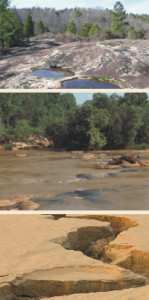 Rock Hawk is located in a physiographic region of Georgia known as the Piedmont. The area contains highly-weathered rolling hills that cover the crystalline bedrock of the Appalachian Mountains. Beneath the soil lie ancient metamorphic and granitic rocks. These rocks form outcrops in many places like Stone Mountain near Atlanta and Flat Rock in Putnam County.
Rock Hawk is located in a physiographic region of Georgia known as the Piedmont. The area contains highly-weathered rolling hills that cover the crystalline bedrock of the Appalachian Mountains. Beneath the soil lie ancient metamorphic and granitic rocks. These rocks form outcrops in many places like Stone Mountain near Atlanta and Flat Rock in Putnam County.
Overlying the bedrock is highly-weathered saprolite clay, broken down from millions of years of chemical decomposition.
In the past, there was a significant topsoil layer on top of the clay. Much of the topsoil was removed by poor soil conservation practices of planters and small farmers during the early days of cotton agriculture and into the twentieth century. An average of seven inches of topsoil was eroded from this region, and major gullies formed in places where soft soils were exposed to the intense summer rains.
The Piedmont is a region of varied topography, as streams continue to degrade sediments and carry them away. Nearby, the Oconee River flows south and east over 300 miles to the Atlantic Ocean near Darien. (The Oconee joins the Ocmulgee River in south Georgia to form the Altamaha which flows to the Atlantic.) The dams created to form Lake Sinclair and Lake Oconee have blocked sediment migration, and the creation of the Soil Conservation Service in the 1930s helped reduce erosion. However, soil stabilization continues to be a concern in this region. As the fertility of the soil declined, many of the cotton farms and plantations were replaced with pine plantations, dairy farms, and eventually suburban developments.
